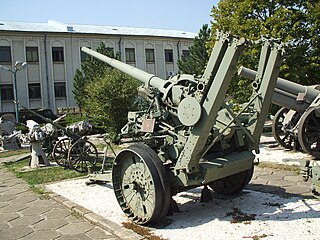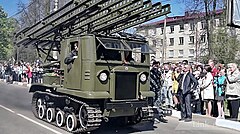Following the outbreak of World War II on 1 September 1939, the Kingdom of Romania under King Carol II officially adopted a position of neutrality. However, the rapidly changing situation in Europe during 1940, as well as domestic political upheaval, undermined this stance. Fascist political forces such as the Iron Guard rose in popularity and power, urging an alliance with Nazi Germany and its allies. As the military fortunes of Romania's two main guarantors of territorial integrity—France and Britain—crumbled in the Fall of France, the government of Romania turned to Germany in hopes of a similar guarantee, unaware that the then dominant European power had already granted its blessing to Soviet claims on Romanian territory in a secret protocol of 1939's Molotov–Ribbentrop Pact.

The IAR 79 was a twin-engine bomber and military reconnaissance aircraft with a wood and metal structure that saw service in World War II built under licence in Brasov, Romania, by Industria Aeronautică Română

Operation Tidal Wave was an air attack by bombers of the United States Army Air Forces (USAAF) based in Libya on nine oil refineries around Ploiești, Romania on 1 August 1943, during World War II. It was a strategic bombing mission and part of the "oil campaign" to deny petroleum-based fuel to the Axis powers. The mission resulted in "no curtailment of overall product output."

T-20 armored tractor Komsomolets(Bronirovannyy gusenichnyy tyagach Komsomolets T-20), an armored continuous track tractor, the T-20 was a prime mover vehicle used by the Soviet Union during the Winter War and World War II.

The ZB-30 and ZB-30J were Czechoslovakian light machine guns that saw extensive use during World War II.

The National Legionary State was a totalitarian fascist regime which governed Romania for five months, from 14 September 1940 until its official dissolution on 14 February 1941. The regime was led by General Ion Antonescu in partnership with the Iron Guard, the Romanian ultranationalist, antisemitic and anti-communist organisation. Though the Iron Guard had been in the Romanian Government since 28 June 1940, on 14 September it achieved dominance, leading to the proclamation of the National Legionary State.

The Air Force branch of the Royal Romanian forces in World War II was officially named the Aeronautica Regală Română (ARR), or the Romanian Royal Aeronautics, though it is more commonly referred to in English histories as the Forțele Aeriene Regale ale României, or simply Forțele Aeriene Române. It provided support to land forces, carrying out reconnaissance and mounting air raids between other missions.
The Orița is a 9×19mm Parabellum submachine gun that was manufactured in Romania during World War II and for several years afterwards. It was named for Captain Marin Orița, who is credited in Romania with its design. The mass production was made by CMC Uzinele Metallurgice Copșa Mică together with Cugir Arms Factory. The first version, Model 1941, entered operational service with the Romanian Army in 1943. Two later improved models were the Model 1948, with a fixed wooden stock, and the rare paratrooper Model 1949, with a folding metal stock. It remained in service with the Romanian Army until it was replaced in the 1960s by the more powerful Pistol Mitralieră model 1963/1965, a Romanian version of the AK-47 assault rifle. The Orița remained in service with the Romanian paramilitaries until the 1970s.

Before 1989, Romania was among the top ten arms exporters in the world, however its arms industry declined considerably during the 1990s. Exports fell from roughly $1 billion before 1989 to about $43 million in 2006, and the number of employees also fell from 220,000 in 1990 to 20,000 in 2009. Sales to the Romanian Armed Forces have plunged after Romania's accession to NATO in 2004, as factories continue to produce Warsaw Pact-caliber weapons and ammunition, which are incompatible with their Western counterparts.

The IAR 37 was a 1930s Romanian reconnaissance or light bomber aircraft built by Industria Aeronautică Română.

The SET 7 was a military trainer and reconnaissance aircraft that was produced in Romania in the mid-1930s. It was originally designed as a conventional single-bay biplane, with slightly staggered wings, a standard undercarriage with fixed tailskid, and a tandem open-cockpit arrangement for the pilot and instructor or observer. Power was supplied by an Armstrong Siddeley Jaguar radial engine, and from the outset the aircraft was equipped for wireless and photographic reconnaissance duties.

Operation München was the Romanian codename of a joint German-Romanian offensive during the German invasion of the Soviet Union in World War II, with the primary objective of recapturing Bessarabia, Northern Bukovina and the Hertsa region, ceded by Romania to the Soviet Union a year before. The operation concluded successfully after 24 days of fighting. Axis formations involved included the Romanian Third and the Fourth Armies and the German Eleventh Army. The invasion was followed by a genocide against the Jewish population of Bessarabia.

The TACAM T-60 was a Romanian tank destroyer used during World War II. It was built by removing the turret of captured Soviet T-60 light tanks and building a pedestal to mount a captured Soviet 76.2 mm (3.00 in) M-1936 F-22 field gun in its place. A three-sided fighting compartment was built to protect the gun and its crew. Thirty-four were built in 1943, and they served in the Jassy-Kishniev Offensive, and the Budapest Offensive.

The Vickers Model 1931 was a British anti-aircraft gun used during the Second World War. The design was rejected by the British and Vickers exported the gun worldwide during the 1930s.

The TACAM R-1 was a small tank destroyer for use by Romania during World War II. It was designed on 22 November 1943 at the request of the Romanian General Staff. Fourteen R-1 vehicles were to be rearmed with 45 mm 20-K guns. Although this vehicle was designed to be used only for security duties, the project was cancelled because it was eventually regarded as a waste of badly needed industrial capacity, the 45 mm gun having been obsolete against most Soviet tanks by then.

The TACAM T-38 was a tank destroyer design proposed to be built in Romania during World War II. It was supposed to be a successor of the similar TACAM R-2, but because of different reasons never entered production.

The T-1 tractor was a project developed by the Romanian Army during World War II. A total of 1,000 were ordered. It was designed to tow a Romanian 75 mm gun. After five prototypes were produced, the project was canceled due to the lack of priority.

R-3 was a proposed Romanian tank design for use in World War II. It was basically a variant of the Czechoslovak S-II-c tank prototype which was going to be built in Romania because of the repeated acquisition failures. Because of political reasons and the limited industrial capacities of both Škoda Works and the Romanian industry, the design never entered production.
During the Second World War, the Kingdom of Romania produced, converted or significantly improved a variety of armored fighting vehicles, ranging from licence-built unarmed artillery tractors to tank destroyers of an original design which ended up - according to some accounts - as inspiration for some German AFV.























